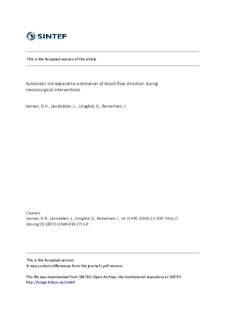| dc.contributor.author | Iversen, Daniel Høyer | |
| dc.contributor.author | Løvstakken, Lasse | |
| dc.contributor.author | Unsgård, Geirmund | |
| dc.contributor.author | Reinertsen, Ingerid | |
| dc.date.accessioned | 2019-02-25T08:23:47Z | |
| dc.date.available | 2019-02-25T08:23:47Z | |
| dc.date.created | 2018-07-08T15:02:32Z | |
| dc.date.issued | 2018 | |
| dc.identifier.citation | International Journal of Computer Assisted Radiology and Surgery. 2018, 13 (5), 693-701. | nb_NO |
| dc.identifier.issn | 1861-6410 | |
| dc.identifier.uri | http://hdl.handle.net/11250/2587119 | |
| dc.description.abstract | Purpose In neurosurgery, reliable information about blood vessel anatomy and flow direction is important to identify, characterize, and avoid damage to the vasculature. Due to ultrasound Doppler angle dependencies and the complexity of the vascular architecture, clinically valuable 3-D flow direction information is currently not available. In this paper, we aim to clinically validate and demonstrate the intraoperative use of a fully automatic method for estimation of 3-D blood flow direction from freehand 2-D Doppler ultrasound. Methods A 3-D vessel model is reconstructed from 2-D Doppler ultrasound and used to determine the vessel architecture. The blood flow direction is then estimated automatically using the model in combination with Doppler velocity data. To enable testing and validation during surgery, the method was implemented as part of the open-source navigation system CustusX (www.custusx.org). Results Ten patients were included prospectively. Data from four patients were processed postoperatively, and data from six patients were processed intraoperatively. In total, the blood flow direction was estimated for 48 different blood vessels with a success rate of 98%. Conclusions In this work, we have shown that the proposed method is suitable for fully automatic estimation of the blood flow direction in intracranial vessels during neurosurgical interventions. The method has the potential to make the understanding of the complex vascular anatomy and flow pattern more intuitive for the surgeon. The method is compatible with intraoperative use, and results can be presented within the limited time frame where they still are of clinical interest. | nb_NO |
| dc.language.iso | eng | nb_NO |
| dc.publisher | Springer Verlag | nb_NO |
| dc.title | Automatic intraoperative estimation of blood flow direction during neurosurgical interventions | nb_NO |
| dc.type | Journal article | nb_NO |
| dc.type | Peer reviewed | nb_NO |
| dc.description.version | acceptedVersion | nb_NO |
| dc.source.pagenumber | 693-701 | nb_NO |
| dc.source.volume | 13 | nb_NO |
| dc.source.journal | International Journal of Computer Assisted Radiology and Surgery | nb_NO |
| dc.source.issue | 5 | nb_NO |
| dc.identifier.doi | 10.1007/s11548-018-1711-0 | |
| dc.identifier.cristin | 1596241 | |
| dc.relation.project | Norges forskningsråd: 237887 | nb_NO |
| dc.description.localcode | This is a post-peer-review, pre-copyedit version of an article published in [International Journal of Computer Assisted Radiology and Surgery] Locked until 13.3.2019 due to copyright restrictions. The final authenticated version is available online at: https://doi.org/10.1007/s11548-018-1711-0 | nb_NO |
| cristin.unitcode | 194,65,25,0 | |
| cristin.unitcode | 194,65,30,0 | |
| cristin.unitname | Institutt for sirkulasjon og bildediagnostikk | |
| cristin.unitname | Institutt for nevromedisin og bevegelsesvitenskap | |
| cristin.ispublished | true | |
| cristin.fulltext | postprint | |
| cristin.qualitycode | 1 | |
